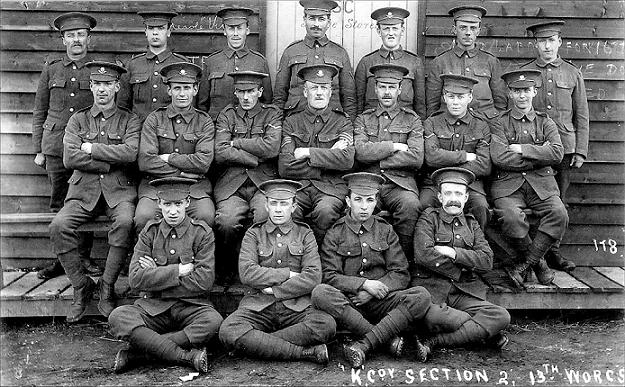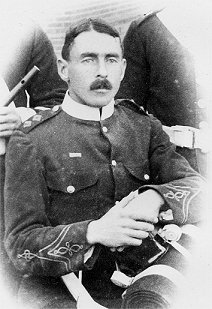13th Battalion Worcestershire Regiment
Formed in Plymouth in November 1914 as a Reserve Battalion of the Fifth " New Army". In November 1914 more “New Army” units were raised, one of which was the 13th Battalions of the Regiment command by Lieut.- Colonel H. de B. Hovell D.S.O., with Captain W. G. Robathan as Adjutant. In April 1915 Colonel Hovell was succeeded by Colonel F. M. Reid. The 13th Battalions originally formed part of the Fifth " New Army". However, before the formation of the new battalion had reached the final stages of its preparations, it was decided to convert it into training units with other new battalions (one of which was the 12th Battalion Worcestershire), to supply reinforcements to replace the anticipated casualties in the preceding Divisions of the” New Armies.” So the 13th Worcestershire never went overseas, but instead sent abroad the soldiers they had trained in drafts to the other Battalions. Thus Midsummer Day of 1916 the 13th Battalion was one of six Worcestershire Battalions which were designated as reserve battalions (the other being the 5th, 6th, 3/7th, 3/8th and 12th). In April 1916 the command of the 13th Worcestershire was taken over by Lieut.-Colonel H. S. Ainslie C.M.G. of the Northumberland Fusiliers (prior to taking command Lieut.-Colonel H. S. Ainslie was commander of the 18th Infantry Brigade before which he commanded the 1st Battalion Northumberland Fusiliers from August 1914 to 28th May 1915). In the summer of 1916 difficulty was being experienced in furnishing drafts at the right moment to replace the losses of the many separate battalions. If the several battalions of each regiment had been grouped into larger brigades their replenishment might have a simpler problem; but the jig-saw puzzle of supplying the needs of several hundred individual units, all engaged at different times with differing results, proved too much for the Administrative Staff of the British Armies in the field. They decided that the business of dealing with each regiment as a water-tight compartment was too complicated to be workable, and in an evil moment they resolved to cross-post drafts as might be needed to meet momentary emergencies. Further, it was decided to form a central “ pool” of unnamed “Training Battalions” to train recruits who should be sent impartially to any unit overseas. |
Lieut.- Col. H. de B. Hovell D.S.O. |
Those new “Training Battalions” were to be formed by amalgamating some of the reserve battalions at home. The Territorial battalions had, fortunately, too strong a popular appeal to be touched: they were permitted to retain their own draft-finding organization, though the Territorial reserve units were reduced and combined. The old “ Militia “ Reserve battalions were not affected, and continued to train and despatch recruits for the Regular battalions of their regiments.
Thus during the autumn of 1916 many changes took place. The two "Third Line" Territorial battalions of the Regiment were amalgamated as the 3/7th Worcestershire. The 12th and 13th Battalions were likewise amalgamated, and were designated "The 46th Training Reserve Battalion" ,which was commanded by Lieut.-Colonel Ainslie from the 13th Worcestershire, with Major Booth and Captain A. G. Richards of the 12th Worcestershire as 2nd-in-command and Adjutant. That unit ceased to have any connection with the Regiment and thenceforward sent drafts to any unit of the armies overseas.

13th Battalion Worcestershire Regiment, 'K' Company, Section 2
Private Stephen (Steven) Oram middle row second from left (Died of wounds 3/9/1916 with 4th Battalion)
Photo submitted by Simon Justice (Private Oram is his Great Uncle)
Timeline of movements
1914 (November) 13th Battalion formed as a Reserve Battalion.
1916 (October) Re-named as "The 46th Training Reserve Battalion".

